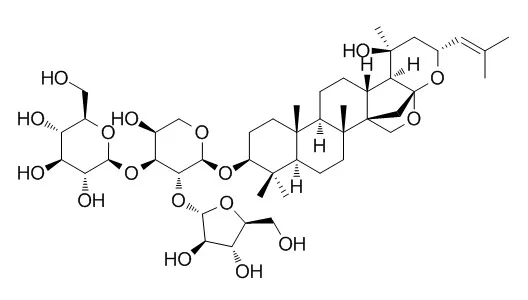| In vitro: |
| Curr Neuropharmacol. 2018 Apr 19. | | Insights into the molecular aspects of neuroprotective Bacoside A and Bacopaside I.[Pubmed: 29676230 ] | Bacopa monnieri, commonly known as Brahmi, has been extensively used as a neuromedicine for various disorders such as anxiety, depression and memory loss.
METHODS AND RESULTS:
Chemical characterization studies revealed the major active constituents of the herb as the triterpenoid saponins, bacosides. Bacoside A, the vital neuroprotective constituent, is composed of four constituents viz., bacoside A3, bacopaside II, jujubogenin isomer of Bacopasaponin C (bacopaside X) and Bacopasaponin C. B. monnieri extracts as well as bacosides successfully establish a healthy antioxidant environment in various tissues especially in liver and brain. Free radical scavenging, suppression of lipid peroxidation and activation of antioxidant enzymes by bacosides help to attain a physiological state of minimized oxidative stress. The molecular basis of neuroprotective activity of bacosides is attributed to the regulation of mRNA translation and surface expression of neuroreceptors such as AMPAR, NMDAR and GABAR in the various parts of the brain. Bioavailability as well as binding of neuroprotective agents (such as bacosides) to these receptors is controlled by the Blood Brain Barrier (BBB). However, nano conversion of these drug candidates easily resolves the BBB restriction and carries a promising role in future therapies.
CONCLUSIONS:
This review summarizes the neuroprotective functions of the B. monnieri extracts as well as its active compounds (bacoside A, bacopaside I) and the molecular mechanisms responsible for these pharmacological activities. | | Phytother Res. 2010 Jun;24(6):864-8. | | Antitumor activities of dammarane triterpene saponins from Bacopa monniera.[Pubmed: 19960417 ] | Bioassay-guided methods were used to test the antitumor activity of methanol extract of the whole plant of Bacopa monniera (L.) Wettst. and four different fractions (petroleum ether, CHCl(3), EtOAc, and n-BuOH fractions) of the methanol extract.
METHODS AND RESULTS:
Among the five crude samples, n-BuOH fraction was noted to have the highest antitumor activity. The dammarane triterpene saponins isolated from n-BuOH fraction, bacopaside E (1) and bacopaside VII (3), had potential antitumor effect. 1 and 3 showed cytotoxicity of all the tested human tumor cell lines MDA-MB-231, SHG-44, HCT-8, A-549 and PC-3M in MTT assay in vitro, and showed 90.52 % and 84.13 % inhibition in mouse implanted with sarcoma S180 in vivo at the concentration of 50 micromol/kg, respectively.
The remaining two compounds, bacopaside II (2) and Bacopasaponin C (4) were found to be much less potent compared with 1 and 3. 1 and 3 significantly inhibited human breast cancer cell line MDA-MB-231 adhesion, migration and Matrigel invasion in vitro at the concentration of 50 micromol/L.
CONCLUSIONS:
Since no antitumor activities about the monomers from Bacopa monniera (L.) Wettst. have been reported, these results indicate that the mechanism of action of 1 and 3 needs further study. |
|






 Cell. 2018 Jan 11;172(1-2):249-261.e12. doi: 10.1016/j.cell.2017.12.019.IF=36.216(2019)
Cell. 2018 Jan 11;172(1-2):249-261.e12. doi: 10.1016/j.cell.2017.12.019.IF=36.216(2019) Cell Metab. 2020 Mar 3;31(3):534-548.e5. doi: 10.1016/j.cmet.2020.01.002.IF=22.415(2019)
Cell Metab. 2020 Mar 3;31(3):534-548.e5. doi: 10.1016/j.cmet.2020.01.002.IF=22.415(2019) Mol Cell. 2017 Nov 16;68(4):673-685.e6. doi: 10.1016/j.molcel.2017.10.022.IF=14.548(2019)
Mol Cell. 2017 Nov 16;68(4):673-685.e6. doi: 10.1016/j.molcel.2017.10.022.IF=14.548(2019)